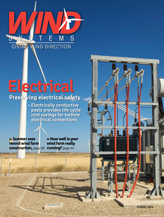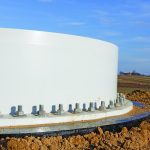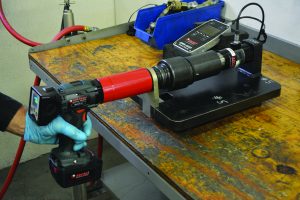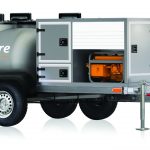Drive down a country road in many states, and you’re likely to see a wind farm on a distant ridge-top sporting a dozen or more wind turbines slowly spinning. Wind farms are becoming ubiquitous, larger, and more complex. Harnessing their power and transferring it to the grid requires this complexity, which now includes power electronics and remote diagnostic systems.
At the same time, manufacturers are also standardizing wind turbine systems to make them similar to other electrical systems familiar to maintenance technicians, using established modular industrial connectors for plug-and-play convenience. Plug-in connectors are used when possible, eliminating the time required by traditional mechanical bolt-type connectors. But are the manufacturers and installers taking a serious look at protecting these electronics? Are they preventively protecting the hundreds of electrical connections in a wind farm? Is it really possible to minimize down time by improving connections? Figure 1
Perhaps the answers lie in looking at how electrical connections on other types of equipment around the world are protected from moisture and corrosion. They often benefit from the use of electrically conductive paste on connections, extending their life span, enhancing safety, and raising their electrical efficiency.
Electrically conductive (EC) paste is designed to work on new and existing connections of all types, including wired, bolted, clamped, blade, plug-in, and crimped varieties. These pastes are NOT the same as dielectric grease, which simply blocks out moisture. EC pastes prevent corrosion from reducing conductivity by keeping moisture out and, most importantly, by cutting through any existing corrosion. The key to their effectiveness is in the sharp, minute, conductive metal particles suspended in oil or grease, which create multiple parallel pathways for electrical current in a connection. In many environments, corrosive electrolytes are present, sometimes from the manufacturing process, producing corrosion even when the eye can’t detect it. Electrical connections near the ocean or other bodies of water especially benefit from the protection pastes afford. Ruggedized computers are available, of course, but paste costs a fraction of the price and lasts a long time. However, selecting a NON-silicone based paste is essential, so that no hardening or residue occurs. Figure 1
EC pastes perform other functions as well. They act as a locking mechanism that prevents loose connections caused by thermal and vibratory stress, common in wind turbines. Some formulas reduce resistance and heat buildup in the electrical interface, an important function in many types of connections, including computer connections. On plug-ins, silver paste also acts as a lubricant and keeps connectors from abrading.
According to John Ebbinghaus, a veteran engineer with Prohm-tect, a manufacturer of electrically and thermally conductive pastes in Sioux Falls, SD, “Paste can be used on all electrical connections safely — even light bulbs — provided the correct formula is applied. Our company produces formulas for computers and other electronics, automobiles, boats, lighting, agricultural equipment, and electric power conversion equipment such as generators, converters, transformers, and inverters. It’s also beneficial on cathodic protection systems and grounding applications.” Figure 2
Originally from New Rochelle, New York, Ebbinghaus developed a unique stainless steel alloy paste in the 1970s for the U.S. Navy to use on guidance systems for jet fighters on aircraft carriers. Today his company produces half a dozen formulas for various applications. They fall into two broad categories, stainless steel and silver. Several types of unique stainless steel pastes are available with varying sizes and amounts of particles, depending on their application. The formulas come in a variety of sizes ranging from 1 cc syringes to 300 cc caulking tubes.
Paste products are typically packaged in syringes, sometimes with a needle tip, for ease of application in small spaces. For field application, kits are available containing a syringe, a lint-free cloth, alcohol wipes, and finger cots for applying the paste. It should be applied in a very thin coat to all faces in a connection after cleaning away loose dirt and other contaminants and drying the connectors with warm air.
Ebbinghaus advises that in computer connections, EC pastes are particularly important when the equipment must operate in harsh environments such as near a body of water or in any humid environment. This means that in wind turbines, especially those offshore, EC paste could make the difference between down time and profitable power production. With industrial Ethernet emerging as a major protocol for monitoring and controlling wind power systems, there is even more motivation for EC-protected connectors, especially if tightly-sealed connectors are not installed in the system. Paste would also protect hybrid connectors, used in many drives and motors with higher levels of intelligence built in. These contain up to eight power contacts and an Ethernet interface in a compact package. Figure 3
To grasp the potential for using EC paste on the connections in wind turbine behemoths, it pays to understand how they operate electrically. Turbines installed on land vary from several hundred kilowatts to three megawatts and generate current at various output voltages ranging from 480 to 1,000VAC with 600 and 690 volts the most common. In a typical farm, underground cables interconnect individual turbines as part of a medium-voltage power collection system and communications network. These are typically 34.5 kV, an industry standard. At a substation on site, a transformer steps this medium-voltage electrical current up to several hundred thousand volts for the high-voltage electric power transmission system. For the 600-volt levels within the turbine, eight or ten cables deliver this low voltage to the step-up transformer. Transformers, with their multiple bolted connections are excellent candidates for the life cycle-lengthening properties of paste.
Using advanced power electronics in each turbine, wind farms regulate their voltage and reactive power levels to ensure they interconnect properly with the electrical grid and to help maintain reliability. As stated in a paper published by Tyco Electronics Energy Division, “Components for the Electrical Network in Wind Turbine Farms,” various connector types include bimetallic lugs, mechanical terminal lugs and connectors, wedge connectors, earthing connectors, and controlled torque shearbolt connectors.
With the collector network underground, reliability becomes critical, as a failure can take several turbines offline. Similarly, a failure in the feed from the collector network to the substation can disrupt the entire wind farm. Because of this, wind turbine manufacturers look at the life-cycle costs of components such as connectors as well as initial costs. Electrically conductive paste can insure that down time is held to a minimum. “An interesting test result with our silver paste,” says Ebbinghaus, “is that in multi-megawatt fuel cell connections, the reduction in resistance provided by the paste actually raised the conductive efficiency of the cell’s output to 94 percent, which was very satisfactory to the manufacturer of the cells. If this dynamic occurs in fuel cell connections, we know that it will transfer to other industries with power connections, resulting in increased power output in addition to huge life-cycle cost savings for their equipment.” Figure 4
According to Lisa Rinaldo, Ebbinghaus’ daughter and Prohm-tect’s owner, “Electrically conductive pastes provide a simple preventive measure against failure, which a lot of people in industry don’t often think about. They assume that if their product is well built, failure is unlikely to happen, and if it does, you just replace the failed parts. But that gets expensive. No electrical connection is completely immune to the wicking of moisture and electrolytes. Actually, about 75 percent of all electrical problems in equipment are due to poor connections. One cc of EC paste can keep a huge, expensive piece of equipment like a wind turbine up and running and save a company manpower and time.”
With wind power generation burgeoning, the industry would profit from looking more and more to the type of preventive maintenance EC pastes can provide, to ensure cost-effective ways of maximizing electrical output, in the process saving themselves thousands of dollars and guaranteeing minimal down time.
































